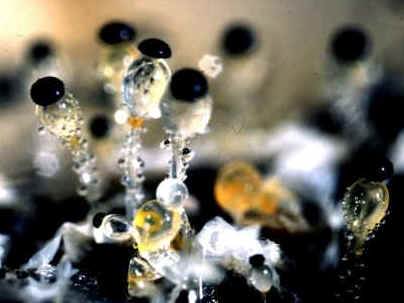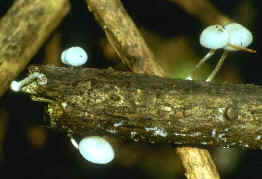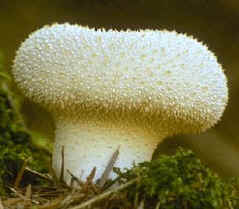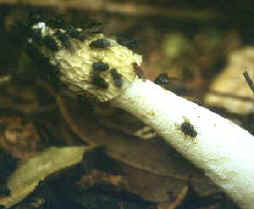The Fascinating World
of Fungi
|
Pilobolus fruiting bodies |
An Article on Fungi by Jeff Benn
Mycological Recorder for the Devonshire Association in South
West England
| The majority of mushrooms and toadstools (known
scientifically as fungi) usually appear in the Autumn in Britain, although quite a few may
be seen at other times of year. Spring produces the St. George's Mushroom (Calocybe gambosa), a lawn and grassland species which is very good to eat. Another fairly common one is Entoloma clypeatum (many fungi, including this one, do not have a common name and can only be mentioned under their less user-friendly, scientific Latin name). The latter fungus grows under bushes belonging to the rose family, such as Hawthorn. These two fungi belong to a section of the Fungus world known as Basidiomycetes. However, many more of the species commonly found in spring, belong to a different section of the fungus world, the Ascomycetes. Some of these are quite small and cup-shaped and may or may not have a stalk. These small 'cup' fungi, as they are known, vary from just 0.5mm across to several centimeters. Many are very brightly coloured. They grow on all sorts of things from decaying vegetation to rotting wood.
The group of fungi known as Ascomycetes also includes some much larger and weirder-looking species called Morels. These can be 15cm tall, with stout stems and caps which are grain-like in appearance. Some of these are edible and are considered to be delicious! The spring fungi quite often grow in the summer as well. If conditions are suitable, autumn species may come up early and can put on quite a show. In the autumn, mushrooms can appear in great numbers. This is because the earth has warmed up and the weather is usually warm and damp. This encourages fungi to grow. The majority of autumn fungi are 'mushroom' shaped, although cup fungi may also be around. If winter is slow to come and fairly mild, some fungi may persist until cold, frost or excess water rots them. There are some species though, which can actually resist frost. These are the 'Winter Fungus' (Flammulina velutipes) and the Wood Blewit (Lepista nuda). The Wood Blewit is not quite so resistant to frost, but can often be seen in January. Fungal Structure All of these visible fungi we have been discussing are the fruiting bodies of the fungus. They are actually only a very small part of the fungus. They are one of the ways in which fungi reproduce themselves and they exist just to produce spores. The spores, when released to a suitable habitat, send out thread-like structures called hyphae, gradually building up a network of these threads called a mycelium. The mycelium can eventually become vast, covering huge areas of land. It absorbs the food it needs from its surroundings. Fungi can be divided into three main groups depending on how they go about this. Some fungi fit into more than one group depending on the circumstances. Fungus Nutrition
Fungi growing on dead wood.
Spore Dispersal The mechanisms used by various species of fungi to spread their spores are very ingenious. An ordinary mushroom releases millions of spores from the gills, dropping them out into the air under the mushroom cap. The wind and air currents will then carry them away.
Birds Nest Fungi have their spores in disc-like packets in the bottom of a 'nest' structure. Raindrops falling into the bucket-shaped nest, scoop out packets of spores and propel them several centimeters away.
Cup fungi produce their spores in sacs called asci, which shoot the spores out several centimeters, well away from whatever they are growing on. The most spectacular display of all comes from a very small fungus, called Pilobolus, which is shaped like a miniature light bulb. This fungus grows on various types of animal dung (click here for a picture). The mycelium is actually breaking down the dung so that it will eventually be recycled and absorbed into the soil. This little light bulb is only 3mm high and with a little black dot on top, which is a packet of spores. The 'light bulb' builds up a pressure of 80lbs per sq. inch (three times the pressure in a car tyre) and at about mid-day, it explodes and propels the packet of spores up about 2 metres in the air and along 2-2.5 metres to land on surrounding grass. Another animal will come along and eat the grass with the spores attached to it. It passes through the gut of the animal and is expelled in the dung, where it proceeds to develop just as before. An extremely efficient method of ensuring the spores find their way into just the right place to grow in their turn! Summary Fungi produce a staggering variety of fruiting bodies. Fruiting bodies of one fungus or another can be found more or less throughout the year in Britain. They come in an enormous variety of colours, shapes and sizes with many intriguing methods for dispersing the millions of spores which they produce. The mushrooms or toadstools which we see are the fruiting bodies of fungi. The main part of the fungal body, or mycelium, is hidden from view in the ground, or in rotting matter. A single mycelium may cover a very large area. Without fungi, life on earth as we know it would not exist. They play a vital role in decomposing dead organisms and returning the resulting nutrients to the soil for plants to reuse. They are also vitally important for the growth of many plants and in particular trees, which may require the contributions from their mycorrhizal fungi in order to flourish.
|




